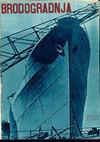EXPLOITATION OF LIQUEFIED NATURAL GAS COLD ENERGY IN FLOATING STORAGE REGASIFICATION UNITS
IF 4.2
4区 工程技术
Q1 ENGINEERING, MARINE
引用次数: 3
Abstract
This paper aims to review regasification technology installed in Floating Storage Regasification Units (FSRUs) and the potential offered by the exploitation of cold energy from liquefied natural gas (LNG) in these vessels. The assessment describes the main characteristics of regasification systems along with their respective advantages and limitations. Regasification systems in direct exchange (seawater and steam) and systems with intermediate fluids that use propane or water-glycol in the heat transfer process are studied. In recent years, water-glycol systems have cornered the market. The mixture, besides reducing the risk of freezing, is non-flammable, economical and highly available. Thermodynamic analysis of the regasification process shows that LNG cold energy is the main source of residual energy in these vessels; the specific energy and exergy content is more than double that of engine exhaust gases. Exploitation of this cold energy in power cycles could significantly reduce FSRUs harmful emissions and electrical energy could even be exported to shore. The organic Rankine cycle technology is the most well-known and widely studied, although scientific literature is scarce and there is a need to propose new regasification systems with cold energy exploitation that can be adopted on these vessels.浮式储罐再气化装置中液化天然气冷能的开发
本文旨在回顾浮式储存再气化装置(fsru)中安装的再气化技术,以及在这些容器中利用液化天然气(LNG)冷能所提供的潜力。该评估描述了再气化系统的主要特点以及各自的优点和局限性。研究了直接交换(海水和蒸汽)中的再气化系统以及在传热过程中使用丙烷或水-乙二醇的中间流体系统。近年来,水-乙二醇系统已经垄断了市场。该混合物,除了降低冻结的风险,是不可燃的,经济和高可用性。再气化过程的热力学分析表明,LNG冷能是这些容器剩余能量的主要来源;比能和火用含量是发动机废气的两倍以上。在电力循环中利用这种冷能可以大大减少fsru的有害排放,电能甚至可以出口到岸上。有机朗肯循环技术是最著名和广泛研究的,尽管科学文献很少,需要提出新的冷能再气化系统,可以在这些容器上采用。
本文章由计算机程序翻译,如有差异,请以英文原文为准。
求助全文
约1分钟内获得全文
求助全文
来源期刊

Brodogradnja
ENGINEERING, MARINE-
CiteScore
4.30
自引率
38.90%
发文量
33
审稿时长
>12 weeks
期刊介绍:
The journal is devoted to multidisciplinary researches in the fields of theoretical and experimental naval architecture and oceanology as well as to challenging problems in shipbuilding as well shipping, offshore and related shipbuilding industries worldwide. The aim of the journal is to integrate technical interests in shipbuilding, ocean engineering, sea and ocean shipping, inland navigation and intermodal transportation as well as environmental issues, overall safety, objects for wind, marine and hydrokinetic renewable energy production and sustainable transportation development at seas, oceans and inland waterways in relations to shipbuilding and naval architecture. The journal focuses on hydrodynamics, structures, reliability, materials, construction, design, optimization, production engineering, building and organization of building, project management, repair and maintenance planning, information systems in shipyards, quality assurance as well as outfitting, powering, autonomous marine vehicles, power plants and equipment onboard. Brodogradnja publishes original scientific papers, review papers, preliminary communications and important professional papers relevant in engineering and technology.
 求助内容:
求助内容: 应助结果提醒方式:
应助结果提醒方式:


